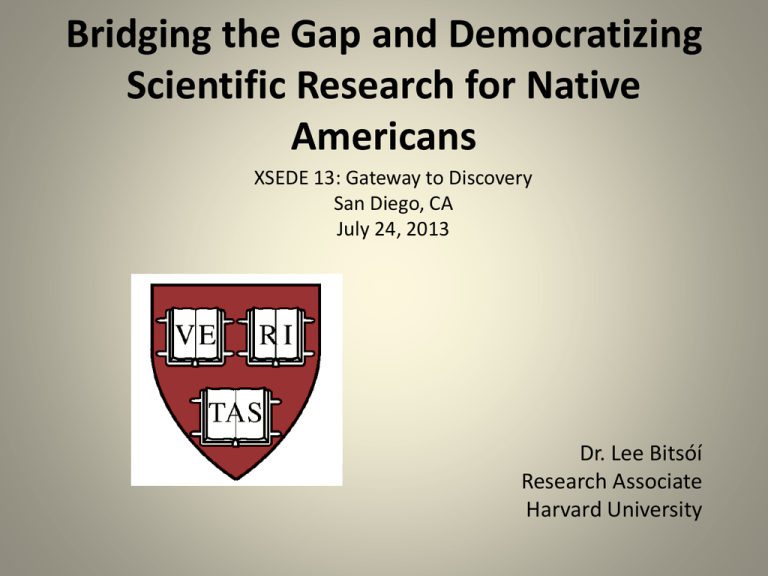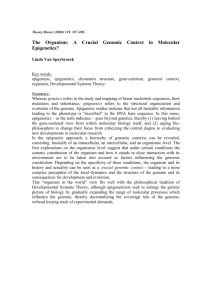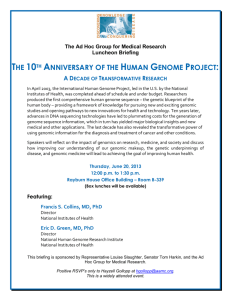present
advertisement

Bridging the Gap and Democratizing Scientific Research for Native Americans XSEDE 13: Gateway to Discovery San Diego, CA July 24, 2013 Dr. Lee Bitsóí Research Associate Harvard University Mitakuye Oyasin and K’e • In the Lakota language, “mitakuye oyasin” describes how we are all related in the universe. • In the Diné language, the word “K’e” embodies a similar perspective regarding relationships while maintaining balance and harmony with the universe. Democratizing Science • In “Custer Died for Your Sins: An Indian Manifesto,” Standing Rock Sioux scholar Vine Deloria Jr. argued that non-Native researchers and academics were mainly interested in their own research goals and advancing their careers, and essentially not concerned about the real challenges that American Indians/Alaska Natives face. • Dr. Frank Dukepoo (Hopi/Laguna) also questioned the bilagaana (Western) approach to research, especially scientific research in American Indian/Alaska Native communities. Dr. Dukepoo always deferred to his Native culture and upbringing whenever he challenged the status quo. • This type of questioning is what Dr. Kim Tallbear (Sisseton Wahpeton) refers to as the first step in democratizing scientific research . As Native scientists and researchers, we have made inroads in many disciplines to advance our understanding of how to optimize scientific discoveries for our people. Democratizing Science • These cultural and language barriers are some of the challenges that I have faced in working with the Navajo Nation to better inform them of the potential benefits of genomic research. • Other Native researchers have also faced similar challenges, but they continue their efforts. • The Navajo Nation Institutional Review Board (IRB) includes scientists, elders, leaders and medicine people and they stress how life is sacred so genetic studies should not be taken lightly. The Platypus and My Uncle • The platypus is native to Australia and is one of the few mammals that lays eggs and has a placenta. – These odd animals also have a duck's bill and thick fur coats adapted for the icy waters where they reside. – The male platypus can produce venom in its hind leg spurs when it is threatened. • A Nature (2008) magazine article describes how an international team (from the United States, Australia, England, Germany, Israel, Japan, Spain and New Zealand) had found that the platypus genome contained approximately the same number (about 18,500) of protein-coding genes as other mammals. • Furthermore, the international team discovered that 80% of the platypus genes are also found in humans, mice, dogs, possums and chickens. • We are all related. • “Sounds like they finally caught up to us...” New Biotechnologies • New technologies often help but also have hindered treating disease and disability for American Indians. • American Indians have a critical role in defining risk benefit that new technologies may bring. • Training native scientists is an active step in this effort to exercise sovereignty in the health arena. • Genomic research lays the foundation for improvements in treatment for illnesses through healthcare tailored to the genotype of individual patients. Prevalence of Heath Conditions by Race/Ethnicity, 2004-2007 SOURCE: KCMU analysis of 2004-2007 NHIS data. American Indian & Alaska Native White, NonHispanic Hispanic Black, NonHispanic Asian and Pacific Islander Two or More Races Two or More Chronic Conditions 18% 10% 6% 11% 5% 9% Diabetes 12% 5% 6% 8% 5% 3% Frequently Anxious or Depressed 23% 16% 13% 14% 8% 21% Obesity 39% 28% 31% 38% 12% 20% Traditional Native Science • • • • • • • • • Math Animal Husbandry Veterinarian Anatomy and Physiology Chemistry Ethnobotany Ethnomedicine Healer Artist Bachelor’s degrees conferred in biological sciences, 2007-2008 SOURCE: U.S. Department of Education, National Center for Education Statistics, 2007-08 Integrated Postsecondary Education Data System (IPEDS), Fall 2008. (This table was prepared June 2009.) Race/Ethnicity Total Male Female All Students 77,854 31,637 46,217 White 50,875 21,853 29,522 Total Minority 24,776 9,413 15,363 Black 6,113 1,639 4,474 Latino 5,180 2,031 3,149 12,961 5,520 7,441 522 223 299 2,203 871 1,332 Asian/Pacific Islander American Indian/Alaska Native Non Resident Alien Doctoral degrees conferred in biological sciences, 2007-2008 SOURCE: U.S. Department of Education, National Center for Education Statistics, 2007-08 Integrated Postsecondary Education Data System (IPEDS), Fall 2008. (This table was prepared June 2009.) Race/Ethnicity Total Male Female All Students 6,918 3,403 3,515 White 3,690 1,873 1,817 1,106 (16%) 485 (14%) 621 (18%) Black 241 91 150 Latino 253 118 135 Asian/ Pacific Islander 595 271 324 17 5 12 2,122 (31%) 1,045 1,077 Total Minority American Indian/Alaska Native Non Resident Alien Doctoral degrees Conferred in 20072008 Source: NCES, U.S. Department of Education, National Center for Education Statistics, 2006–07 Integrated Postsecondary Education Data System (IPEDS), Fall 2007. (This table was prepared July 2008.) American White Indian & Alaska Native Black Hispanic Asian and Pacific Islander NonResident Alien Health Sciences/Clinical Sciences 26 6,530 363 255 483 698 Biological and Biomedical Sciences 23 3,463 182 203 566 1,917 Physical Sciences and Science Technologies 10 2,233 100 107 249 2,147 Computer and Information Sciences 3 496 34 19 127 916 Reluctance to Participate • Since the Human Genome Project, American Indians have increasingly declined to participate as subjects in genomic research for multiple reasons. • • • • Havasupai Tribe v. Arizona Board of Regents Navajo Nation Moratorium on genetic research studies Exploitation of Blood Samples: Over 20 years ago, the Nuu-chah-nulth (Nootka) tribe in Canada donated blood for research into the genetic causes of rheumatoid arthritis, a disease that is rampant in their tribe. In 2002, they discovered that the specimens have been used for other research--another example of exploitation of indigenous peoples. (Dalton, 2002) Indigenous Models for Research • American Indian communities have begun experimenting with new mechanisms for engaging with the scientific community, including the training of their community members as research staff and investigators. • The Canadian Institutes of Health Research (CIHR) has engaged in extended consultations and deliberations with Canadian indigenous communities to develop guidelines that protect indigenous participants and promote research. • The Navajo Nation Health Research Code was developed by the Navajo Nation to determine and control any research studies that are to be undertaken within the Navajo Nation. Pro-Indigenous Approach: Four New Methods Warrant Special Attention 1. Consulting with local communities. 2. Negotiating the complexities of consent. 3. Training members of local communities in science and healthcare. 4. Training scientists to work with indigenous communities. Implicit is a new definition of “rigorous scientific research,” one that includes both community development and scientific progress as legitimate objectives of genomic research. Source: Jacobs, Bette, Jason Roffenbender, Jeff Collmann, Kate Cherry, LeManuel Lee Bitsói, Kim Bassett, and Charles H. Evans, Jr. 2010. Bridging the divide between genomic science and indigenous peoples. Journal of Law, Medicine & Ethics (Fall): 684-696. Minority Action Plan of the National Human Genome Research Institute • NHGRI is committed to increasing the number of individuals from underrepresented minority groups (Native Americans, Latino, African Americans, Pacific Islanders) who have the training to pursue careers in genome (genomics and bioinformatics) sciences, as well as ethical, legal and social implications (ELSI) research. • History of MAP programs: – April 2001: the NHGRI convened a meeting to explore new and innovative ideas and models for increasing the number of underrepresented minorities (URM) pursuing research careers in genomics and related sciences. – October 2003: First MAP meeting was held. – February 2007: First MAP Coordinators workshop was held. – April 2011: A national database to track MAP participants was established. ELSI: Genomics in Native America • The National Human Genome Research Institute of the National Institutes of Health established the ELSI program in 1990 “To foster basic and applied research on the ethical, legal and social implications of genetic and genomic research for individuals, families and communities.” • Thus, there are opportunities through ELSI for lawyers, sociologists, anthropologists, and even business entrepreneurs to address multiple ethical, legal and social issues that are best explored using multidisciplinary approaches. • For example, there is a need for more Native Americans to represent their communities when it comes to genetic testing and teaching science. There should be culturally appropriate methods and processes, as there has been a history of mistrust with the scientific community. • If we, as Native Americans, are trained in these fields, we can play key roles in the development of scientific discovery that will benefit our nations. Partnerships • GENA (Genetic Education for Native Americans): A curriculum was developed and implemented in workshops primarily in conjunction with regional and national scientific conferences that include substantial numbers of Native American attendees (GENA). • Society for Advancement of Chicanos/Latinos and Native Americans in Science (SACNAS) • American Indian Science and Engineering Society (AISES) • National Congress of American Indians (NCAI) My Role • To get underrepresented minority students excited about genomics and connect them with scientists at genome centers around the country. • Inform prospective students that the study of genomics is more than discovering similarities between living organisms. – For example, genomic investigations are currently responsible for disease prevention and even cures. • Research in this area could lead to the development of new drugs to treat diseases like diabetes, better methods of crop production, better range management of land, and possibly discovering new and innovative ways to sustain the earth. • Essentially, it could lead to a greener future for the world. • Continue to delve into ELSI research and other interesting related topics. Intergenerational Trauma • Intergenerational or historical trauma (HT) has been a controversial topic for non-Native people since there is an accepted notion that what happened in the past is in the past. • However, scientific research in epigenetics has begun to demonstrate that intergenerational trauma is real and has an impact on present day populations, and what we experience will have affects on future generations. • Native healers, medicine people and elders have always known this and it is common knowledge in Native oral traditions. • Bryan Brayboy (2005) uses TribalCrit to emphasize this by stating, “Stories are not separate from theory; they make up theory and are, therefore, real and legitimate sources of data and ways of being” (P. 430). Epigenetics • “At the heart of this new field [epigenetics] is a simple but contentious idea – that genes have a 'memory'. That the lives of your grandparents – the air they breathed, the food they ate, even the things they saw – can directly affect you, decades later, despite your never experiencing these things yourself. And that what you do in your lifetime could in turn affect your grandchildren”—BBC, The Ghost in Your Genes. • “Epigenetics adds a whole new layer to genes beyond the DNA. It proposes a control system of 'switches' that turn genes on or off – and suggests that things people experience, like nutrition and stress, can control these switches and cause heritable effects in humans” (BBC, 2012). HT and Diabetes • • • • Dr. Melissa Walls (Ojibwe), Professor at the University of Minnesota Duluth Medical School, studies the social aspects of disease among indigenous people. Dr. Walls is leading a longitudinal study that will follow a cohort of 250 people for four years, periodically monitoring their self-reported stress levels and measuring their blood sugar and cortisol levels. Chronically elevated levels of cortisol, a stress hormone, can increase blood sugar and inhibit the effects of insulin, leading to or compounding diabetes. Type 2 diabetes is the fourth-leading cause of death among indigenous Americans and a major contributor to cardiovascular disease, the No. 1 killer in this population. American Indians and Alaska Natives are more than twice as likely as other Americans to have diabetes. Dr. Walls’ goal is to develop treatment protocols for indigenous people that take into account their culture and history. This population copes with a disproportionate number of stressors, says Walls, naming several: economic disadvantage, unemployment, community violence, discrimination, and the long-term effects of historical traumas. – HT as an etiological agent: Lived HT experiences may contribute to PTSD, grief, depressive symptoms, etc. Economic, political, and religious institutions of the European settlers all contributed to the displacement and oppression of indigenous people” (Kirmayer, Tait, and Simpson 2009, p. 7; see also King, Smith, and Gracey 2009) Social Justice, Health Care, Preservation for Future Generations • “Epigenetics is an exciting new avenue of scientific exploration that already has demonstrated that certain exposures, especially during periods of developmental vulnerability, can cause long-term harms to exposed individuals and sometimes their progeny. Epigenetics invalidates the assumption that nature and nurture operate as independent forces in influencing human development and disease. • Numerous legal and ethical issues are raised by epigenetics, especially regarding individual and societal responsibilities to prevent hazardous exposures, monitor health status, and provide care. Epigenetics represents a new class of biological effects from harmful exposures and adds a multigenerational dimension to environmentally-caused adverse health effects. Epigenetics serves to highlight the effects of inequality in living and working conditions, as well as a range of disparities in access to health care and other societal opportunities. • Finally, epigenetics raises difficult questions about the obligations of society to preserve the soundness of the human genome and epigenome for the benefit of future generations. In developing a principle of intergenerational equity for the human genome and epigenome, optimum social policy lies between indifference to the health burdens of future generations and eugenic notions of manipulating heredity to improve the human condition” (p. 62). Source: Mark A. Rothstein, Yu Cai and Gary E. Marchant. The Ghost in Our Genes: LEGAL AND ETHICAL IMPLICATIONS OF EPIGENETICS, Health Matrix: Journal of Law Medicine, Case Western Reserve University, Vol 19: 1, 1-62, 2009 References • • • • • • • • Arizona Court of Appeals. Havasupai Tribe V. Arizona Board of Regents. (2008). [cited 2008 Dec 4]. Available from: http://www.cofad1.state.az.us/opinionfiles/CV/CV070454.pdf. BBC. (2012). The ghost in your genes. Retrieved on December 1, 2012, from http://www.bbc.co.uk/sn/tvradio/programmes/horizon/ghostgenes.shtml. Brayboy, B. M. (2005). Toward a tribal critical race theory in education. The Urban Review, 37(5), 425-446. Canadian Institutes of Health Research [CIHR] CIHR guidelines for health research involving aboriginal people. (2007). [cited 2009 Jan 22]. Available online: http://www.cihr-irsc.gc.ca/e/29134.html Dalton, R. (2002). Tribe blasts ‘exploitation’ of blood samples. Nature Vol 420, Nov. Developing a Framework to Guide Genomic Data Sharing and Reciprocal Benefits to Developing Countries and Indigenous Peoples. A Colloquium held January 7-8, 2009, Georgetown University, Washington, DC. GENA. Dignan, M. B., Burhansstipanov, L., and Bemis, L. Successful implementation of genetic education for Native Americans workshops at national conferences. Genetics Vol 169, (Feb 2005). Harmon, A. (2010). Indian Tribe Wins Fight to Limit Research of Its DNA, New York Times, April 21, 2010, Amy HarmonJacobs, Bette, Jason Roffenbender, Jeff Collmann, Kate Cherry, LeManuel Lee Bitsói, Kim Bassett, and Charles H. Evans, Jr. (2010). Bridging the divide between genomic science and indigenous peoples. Journal of Law, Medicine & Ethics (Fall): 684-696. References • • • • • • • • • KCMU analysis of 2004-2007 NHIS data. King Malcolm, Smith Alexandra, Gracey Michael. Indigenous Health Part 2: The Underlying Causes of the Health Gap. The Lancet. 2009; 374:76–85. Kirmayer Laurence, Tait Caroline, Simpson Cori. The Mental Health of Aboriginal Peoples: Transformations of Identity and Community. In: Kirmayer L, Valaskakis Gail G, editors. Healing Traditions: The Mental Health of Aboriginal Peoples in Canada. Vancouver, BC: UBC Press; 2009. pp. 3–35. Le, C. N. (2009). “Socioeconomic Statistics & Demographics” Asian-Nation: The Landscape of America. www.asian-nation.org/demographics.shtml Navajo Nation Health Research Code, Navajo Nation Council, April (2002). Navajo Nation Moratorium on Genetic Research Studies, Navajo Nation Council, April (2002). NCES, U.S. Department of Education, National Center for Education Statistics, 2006–07 Integrated Postsecondary Education Data System (IPEDS), Fall (2007). Walls, M. (2013). Where stress, diabetes, and culture converge, UM Duluth Medical Bulletin, retrieved July 10, 2013, from http://blog.lib.umn.edu/mmf/news/bulletin/2013/where-stress-diabetes-andculture-converge.html Warren, W. C. & et al. (2008). Genome analysis of the platypus reveals unique signatures of evolution, retrieved July 10, 2013, from Acknowledgements • • • • XSEDE13: Nancy Wilkins-Diehr, Richard Tapia Professors William M. Gelbart, MCB Harvard Professor George Church, HMS Harvard Professor Bette Jacobs, Georgetown Law School • Professor Jeff Collman, Georgetown Medical School For more information: • Email: bitsoi@fas.harvard.edu • NCAI: http://genetics.ncai.org/ • NCAI Genetics: http://genetics.ncai.org/enhancing_genomic_ research.cfm • NHGRI MAP: www.genome.gov/14514219







